Table of contents
Frequently asked questions (FAQ) Copy link to clipboard
Frequently asked questions about itemis ANALYZE.
Licensing and download Copy link to clipboard
Who can benefit from itemis ANALYZE? Copy link to clipboard
itemis ANALYZE supports everyone who needs to ensure traceability over the toolchain. It supports all user groups in performing their tasks in the context of traceability.
- Your task is to create and manage trace links? itemis ANALYZE gives you the means to create links manually as well as automatically derive them from artifact data, based on an individual scheme. If artifact data or link data change, itemis ANALYZE helps you ensure that links are still valid.
- Managers will welcome itemis ANALYZEs rich dashboard and reporting functionalities, providing them with an overview on the current project and its traceability status, e.g. the current coverage of requirements by successful test cases. itemis ANALYZE query language is a powerful tool to formulate even very complex project-specific questions, to be answered once or on a regular basis.
- If you are a system administrator, itemis ANALYZE supports you in setting up configurations in such a way that your fellow employees can access their proper data easily.
What is itemis ANALYZE Quickstart edition for? Copy link to clipboard
The driver for the Quickstart edition is to quickly create meaningful traceability analysis. If you are in the situation, for example, that you maintain your Requirements Traceability Matrix \„by hand\” (e.g. in Excel), you know how error-prone this can be. The Quickstart Edition does exactly this work for you – and you can define even more meaningful analyses with it.
To make sure that this is done quickly, we help you with this – that’s why a free day of consulting is included.
With the Quickstart Edition you can evaluate data from Word, Excel and C/C++. If you want to connect even more tools, you might want to consider the Professional Edition.
Please contact us if you have any further questions.
How can I get a demo version? Copy link to clipboard
itemis ANALYZE is highly configurable to integrate with the toolchain you are using. Therefore, we provide two demo/evaluation options:
- Self-guided evaluation: This evaluation offer comprises a demo version supporting a fixed set of adapters. It comes with a populated workspace representing a “small V-model” which consists of stakeholder requirements and software requirements, specified in Microsoft Word documents, test specifications in Microsoft Excel, a Matlab Simulink design, and some C source code. In order to illustrate the analysis capabilities of itemis ANALYZE, sample traceability queries and reports are already set up for you. You may want to look at the included videos to learn more about the features of itemis ANALYZE. Download the self-guided evaluation.
- Guided evaluation: We are also offering to set up itemis ANALYZE together with you and suited for your specific needs. We will configure itemis ANALYZE according to your use cases and demonstrate how it can really chain your tools. Working closely together, we will provide customized solutions for your particular problems. As a side effect, the knowledge transfer happens en passant. Feel free to contact us any time to ask about the details of this offer.
In either case, the evaluation period is not limited strictly – we always suggest to choose your weapons carefully.
What does itemis ANALYZE cost? Copy link to clipboard
itemis ANALYZE consists of core functionalities plus different adapters allowing you to connect to the tools in your toolchain. By way of these adapters you can access data from these tools and create trace links between them. The costs for itemis ANALYZE largely depend on the adapters you need. Please contact us to give us information about your toolchain, and we will be glad to give you an overview on the costs.
Setting up itemis ANALYZE Copy link to clipboard
How and where does itemis ANALYZE save the link information? Copy link to clipboard
This is highly configurable and to a large degree depends on your toolchain processes and preferences. You can either store links in itemis ANALYZE’s own link storage file format, leaving your artifacts unaffected. Alternatively, you can maintain the links invasively within the artifacts. For example, you could save link information as cells in an Excel sheet or as comments in a Java source file. What is possible and how it works in detail differs from tool to tool. Non-invasive and invasive approaches both have there specific advantages. You can even mix both approaches.
The documents itemis ANALYZE analyzes need to be in a “workspace”. What is a “workspace”, and how can I add documents to it? Copy link to clipboard
Technically, itemis ANALYZE rests upon the Eclipse platform, and the latter provides a very flexible resource management. The workspace bundles the data you are working with in a single place, no matter whether they reside physically. The spectrum of functions comprises implicit or explicit copies, symbolic links for files and folders, and more ( Help ).
Can I instruct itemis ANALYZE to automatically refresh link information after document changes, e.g. after editing an Excel file containing test case specifications? Copy link to clipboard
Yes, you can control the refresh behaviour by means of the preference settings. If you check “Refresh using native hooks or polling” in the general workspace preferences, ANALYZE refreshes automatically after changes.
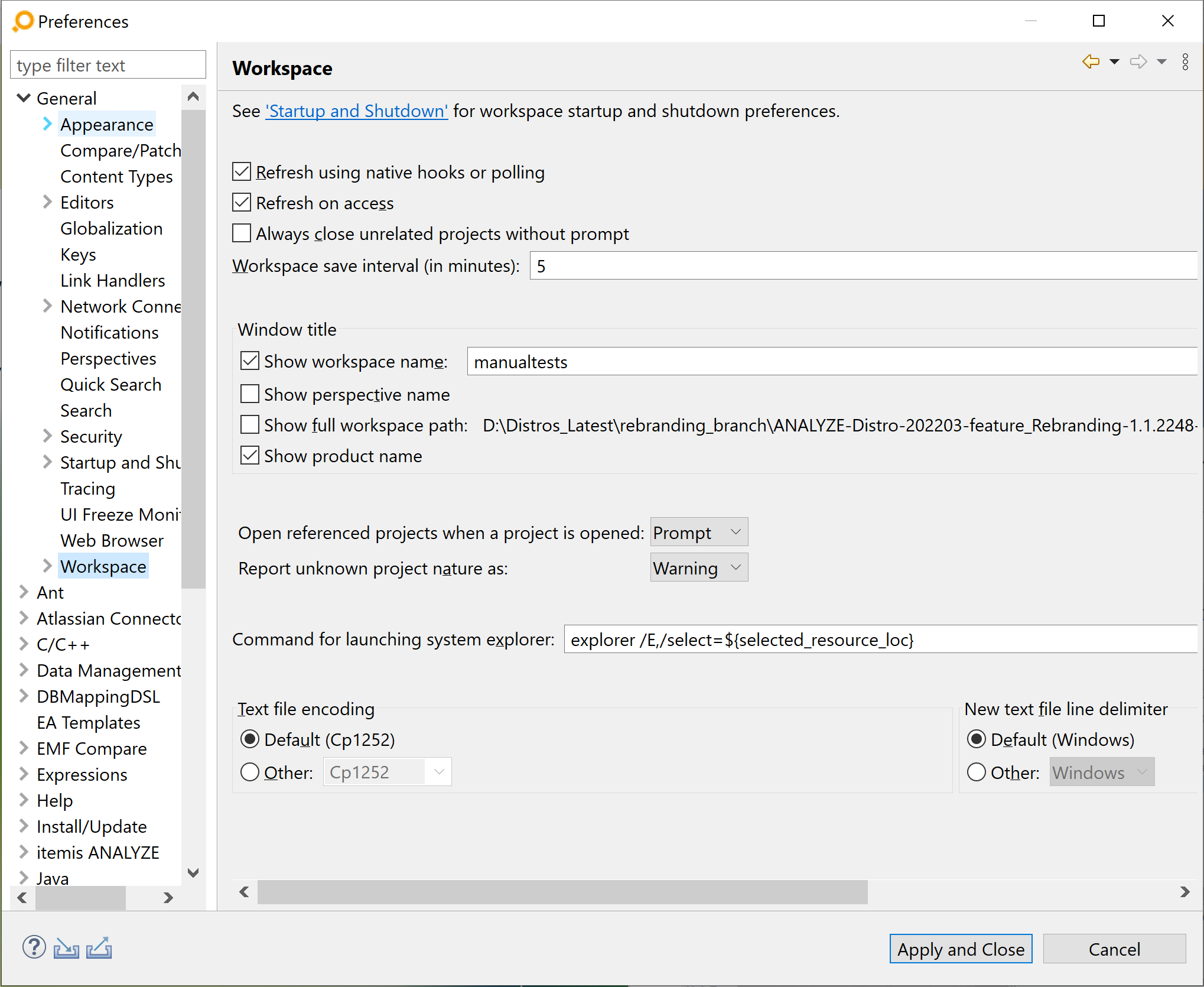
Is it possible to address different baselines in IBM DOORS? Copy link to clipboard
Yes. The IBM DOORS adapter can be configured in a way to consider only artifacts and links that are present in a certain baseline. You can find more about this feature in the ANALYZE documentation.
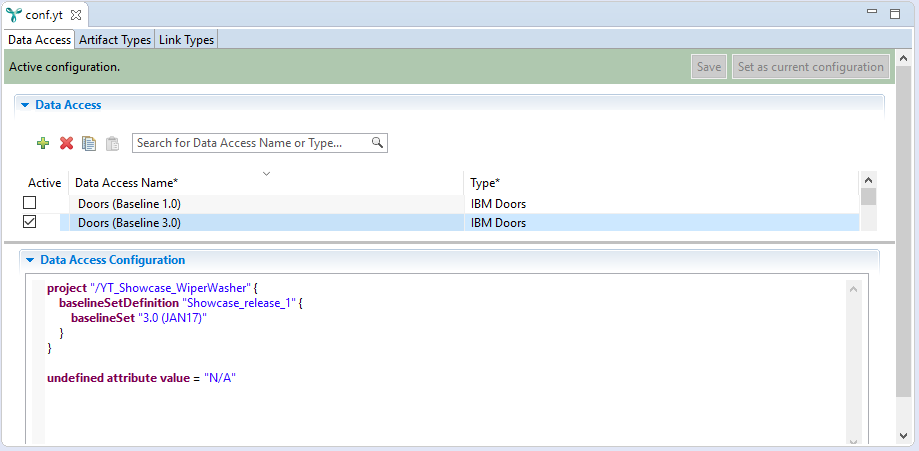
Linking artifacts Copy link to clipboard
Which tool can be connected with itemis ANALYZE? Copy link to clipboard
itemis ANALYZE has a large number of tool adapters. In addition, with our generic adapters for XML or Text we can analyze data from all tools that support these formats.
I cannot find any unlinked artifacts in the ANALYZE Explorer view. Why are they not shown? Copy link to clipboard
Per default, the ANALYZE Explorer view displays linked artifacts only. However, there is an easy means to also show unlinked artifacts: In the toolbar of the ANALYZE Explorer view, click on the “Show also unlinked artifacts” button. ANALYZE Explorer will now present linked as well as unlinked artifacts. You can identify unlinked artifacts in the tree by the icon in front of the artifact name: It’s adapter icon is decorated with the icon used in the toolbar.
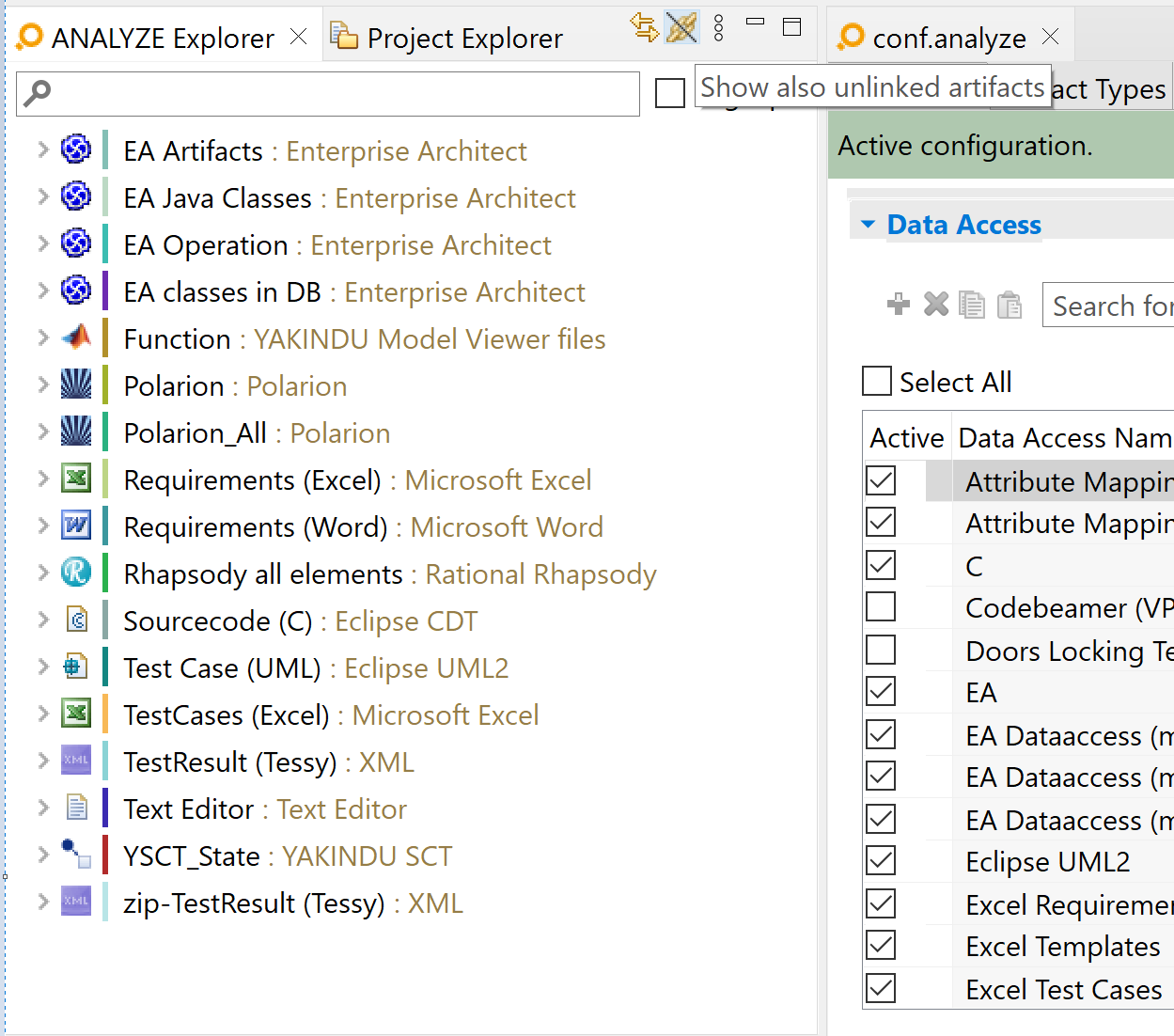
The ANALYZE Explorer view only shows linked artifacts … but how can I see all links of a given type? Copy link to clipboard
ANALYZE Explorer shows its content in groups. You can choose from four different grouping rules, which are explained in detail in section Show links based on different groupings in the ANALYZE documentation. Select the link type grouping to order the artifacts based on their link types.
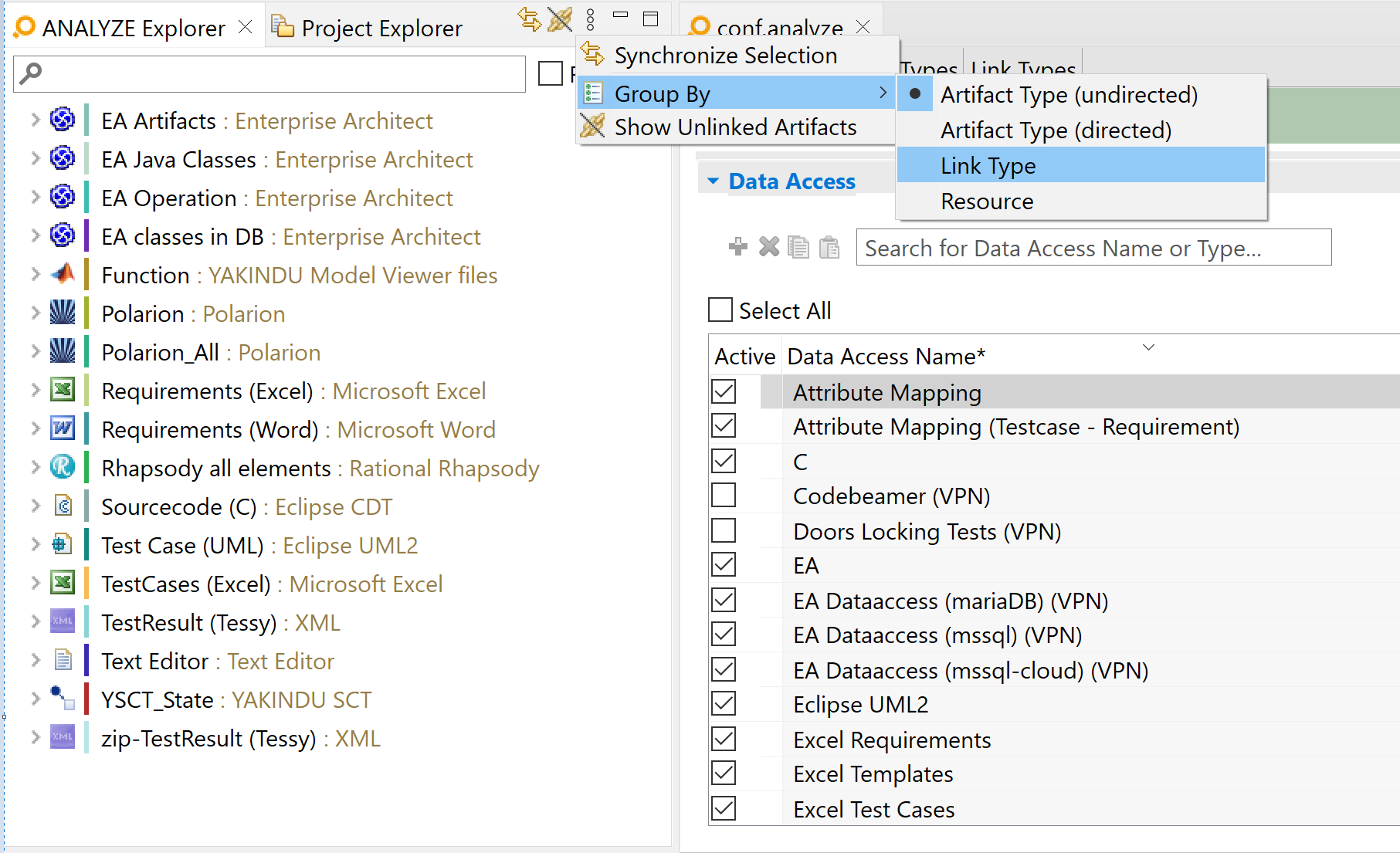
Does itemis ANALYZE support forward, backward, or bidirectional traceability? Copy link to clipboard
Yes, itemis ANALYZE supports directed as well as bidirectional traceability. In the ANALYZE configuration, you can define which type of artifact can be linked with which other type – the direction is not important here. However, ANALYZE Overview provides a toggle button that allows you to analyze traceability either bidirectionally or undirectionally. More on this in our blog post “About bidirectional traceability, link semantics and a toggle button":https://blogs.itemis.com/en/about-bidirectional-traceability-link-semantics-and-a-toggle-button.
Project status and reports Copy link to clipboard
Is it possible to track project progress with itemis ANALYZE? Copy link to clipboard
itemis ANALYZE provides different means to analyse the current status of your project. For example, the ANALYZE Dashboard view displays pie charts with all artifacts, linked artifacts or unlinked artifacts.
To support some deeper analysis, itemis ANALYZE comes with an easy-to-use query language for the creation of all kinds of custom metrics. We provide various query templates to support you in writing your own queries.
Also, you can generate custom reports answering your individual, project-specific questions and export the results, for example in Excel.
Find out more about how to analyse the traceability status of your project in the ANALYZE documentation.
I need nightly/weekly reports. Can I run itemis ANALYZE on a server? Copy link to clipboard
Yes, this is possible. itemis ANALYZE can run on continuous integration servers, such as Jenkins, Travis, etc. This allows to execute queries and export the results or to create individual reports in a regular manner. It is also possible to write the results into a database.
How do I create a traceability matrix? Copy link to clipboard
You can create a traceability matrix by use of itemis ANALYZE’s query language. Navigate to the ANALYZE Queries view, e.g. in the Analysis perspective, and open a query file. In that file, please add the following query and replace the green-colored artifact type names by names of your own configuration. Tip: While editing the query file, press [Ctrl+Space] to be supported by code completion proposals and template suggestions. To create a traceability matrix, you can use the query template “Trace Matrix”.
Save the query file and execute the created query in the ANALYZE Queries view. The traceability matrix will be shown in the ANALYZE Query Results view.

How can I find out which requirements are not yet linked? Copy link to clipboard
itemis ANALYZE provides different means to identify unlinked artifacts, like requirements. One way is to activate the switch "Show also unlinked artifacts" in the ANALYZE Explorer view and navigate to the artifact type configured for your requirements. Alternatively, you can use the ANALYZE Dashboard view that can be found in the Analysis perspective. In the dropdown field, select "Not linked artifacts". Afterwards, click on the pie section of the type you are interested in. ANALYZE Dashboard Details will show you a list with all unlinked artifacts of this type.
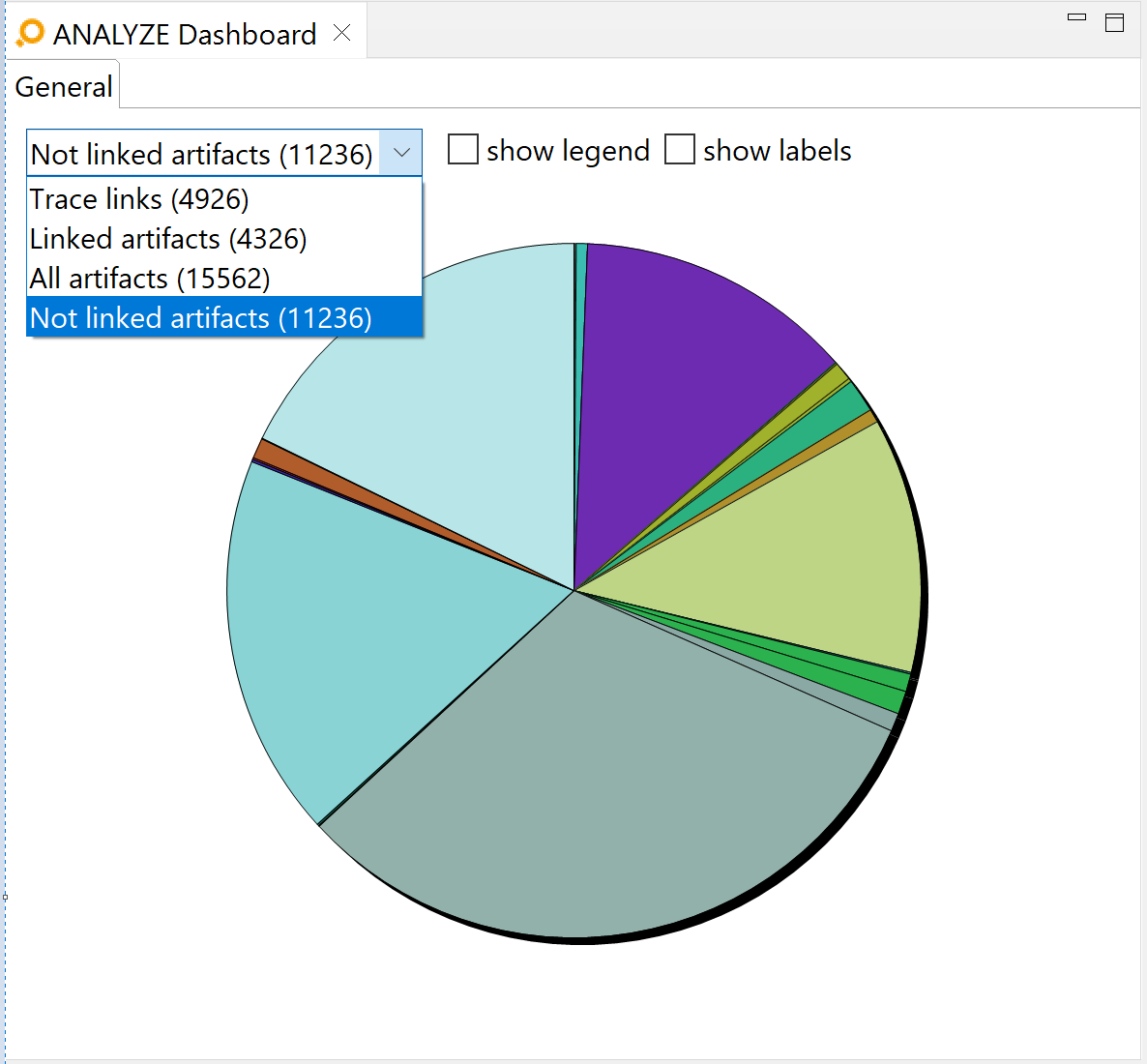
You can also use the query language to answer this question. Navigate to the ANALYZE Queries view, e.g. in the Analysis perspective, and open a query file. In that file, please add the following query and replace the green-colored artifact type names by names of your own configuration. Tip: While editing the query file, press [Ctrl+Space] to be supported by code completion proposals and template suggestions. To identify unlinked artifacts, you can use the "All unlinked artifacts for" query template.
Save the query file and execute the created query in the ANALYZE Queries view. The unlinked artifacts will be shown in the ANALYZE Query Results view.

For all test cases, I want to know the exact number of requirements that are verified by each test case. How can itemis ANALYZE help me with analyzing my traceability data? Copy link to clipboard
itemis ANALYZE’s query language includes a function to count elements. You can set up a query that first collects all traces from one artifact type to another artifact type and then use the @count function at the end of your query. The following example would result in a list of “Software Requirements” linked with “Software qualification test results”. The last column of that list contains the number of “Software qualification test results” linked to the corresponding “Software Requirement”.

My process mandates that all artifacts of type A are linked to artifacts of type B. I automatically derive the links using attribute mapping. Now I want to know which artifacts have no links. How can itemis ANALYZE help me identify gaps in my traceability? Copy link to clipboard
This is a typical use case for the query language. The example below shows how to find all “Software Requirements” that have the attribute “Needs test” set to true and are not linked to a respective “Software qualification test specification”.

Others Copy link to clipboard
My project has strict traceability requirements as defined in a specific ISO norm, e.g. ISO 26262, Automotive Spice, DOA178, EN 50128, etc. Can itemis ANALYZE help me comply to these process standards? Copy link to clipboard
Our idea is to adjust itemis ANALYZE to your process and not to adjust your process to our tool. Therefore it is highly configurable and expandable, e.g. to support new tools. This gives you the perfect basis to comply with your process standards. Furthermore, we have a lot of experience in introducing traceability in companies that need to comply with process standards. So we can also provide you with professional consulting services in setting up the necessary traceability level in your company, based on our experience in this domain.